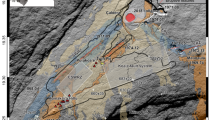Abstract
In low to moderate tectonically active areas, such as intracontinental regions with deep reaching zones of crustal weakness, direct observations of surface faulting offsets are very scarce and the seismic record is often incomplete and small. This complicates the study of a possible surface faulting hazard and requires new analysis concepts. In the case study presented in this paper, the seismic hazard potential of an already defined nuclear power plant site located in such a moderate active region had to be reassessed, and the possible effects of surface faulting had to be quantified.
Résumé
Dans les secteurs à activité tectonique faible ou moyenne, telles que les régions intracontinentales avec des zones de faiblesse de la croûte très profonde, des observations directes des fracturations de surface sont très dispersées et les données sur la seismicité incomplètes. Ceci complique l'étude d'un éventuel risque dû à la fracturation de surface et nécessite d'utiliser de nouveaux concepts d'analyse. Dans l'exemple présenté dans cet article, le risque sismique lié à un site de centrale nucléaire déjà défini a dû être réexaminé et les effets éventuels d'une fracturation de surface ont été quantifiés.
Similar content being viewed by others
References cited
AHORNER L., 1975: Present-day stress field and seismotectonic block movements along major fault zones in Central Europe: Tectonophysics 29, 233–249.
AMBRASEYS N.N., and TCHALENKO J.S., 1972: Seismotectonic aspects of the Gediz, Turkey, earthquake of March 1970: Geophys. J.R. astr. Soc. 30, 229–252.
BONILLA M.G., 1970: Surface faulting and related effects, in: Wiegel (ed): Earthquake Engineering, Prentice Hall Inc. Englewood Cliffs.
BONILLA M.G., 1979: Historic surface faulting—map patterns, relation to subsurface faulting, and relation to pre-existing faults: Proceedings of conference VIII, Analysis of actual fault zones in bedrock.
BONILLA M.G., 1982: Evaluation of potential surface faulting and other tectonic deformation: N.U.R.E.G./C.R.-2991, U.S. Nuclear Regulatory Commission, Washington, N.R.C.F.I.N. B5535.
BONILLA M.G., MARK R.K., and LIENKÄMPER J.J., 1984: Statistical relations among earthquake magnitude, surface rupture length, and surface fault displacement: Bull. Seism. Soc. Amer. 74/6, 2379–2411.
BONJER K.P., 1985: The seismicity of the Rhinegraben rift system— source parameters, propagation- and site effects-, in: Melchior, P., (ed), Seismic Activity in Western Europe: Reidel Publishing Company, 71–83.
BONJER K.P. and APOPEI I., 1986: The southernmost Rhinegraben and Dinkelberg area: Sonderforschungsbereich 108 der Universität Karlsruhe. Band 1984–1986, 99–113.
BONJER K.P., GELBKE C., GILG ROULAND D., MAYER-ROSA D., and MASSINON B., 1984: Seismicity and dynamics of the Upper Rhinegraben: Journal of GEOPHYSICS 55, 1–12.
BROWN L.D., and REILINGER R.E., 1986: Epeirogenic and intraplate movements, in: Geophysics Study Committee, Active Tectonics, National Academy Press, Washington D.C.
BRUNE J., 1968: Seismic moment, seismicity and rate of slip along major fault zones. J. Geophys. Res. 73, 777–784.
GARDNER T.W., JORGENSEN D.W., SHUMAN C., and LEMIEUX C.R., 1987: Geomorphic and tectonic process rates: Effects of measured time interval: Geology, v. 15, 259–261.
GUTENBERG B., and RICHTER C.F., 1954: Seismicity of the earth and associated phenomena: Hafner publishing C., New York.
HALDIMANN P., NAEF H., and SCHMASSMANN H., 1984: Fluviatile Erosions- und Akumulationsformen als Indizien jungplei stozäner und holozäner Bewegungen in der Nordschweiz und angrenzenden Gebieten: Ber. N.T.B. 84-16. Nagra, Baden.
International Atomic Energy Agency I.A.E.A., 1979: Earthquakes and Associated Topics in Relation to Nuclear Power Plant Siting, A Safety Guide: I.A.E.A. No. 50-SG-S1, Vienna.
ILLIES J.H., 1975: Recent and paleo-intraplate tectonics in stable Europe and the Rhinegraben rift system: Tectonophysics 29, 251–264.
ILLIES J.H., and GREINER G., 1979: Holocene movements and state of stress in the Rhinegraben rift system: Tectonophysics 51, 349–359.
KOBAYASHI Y., 1976: Hazards from surface faulting in Earthquakes: Bull. Disaster Prevention Res. Inst. (Kyoto, Japan) 26/4, 213–240.
LAUBSCHER H.P., 1987: Die tektonische Entwicklung der Nordschweiz: Eclogae geol. helv. 80/2, 287–303.
MARUYAMA T., 1964: Statical Elastic Dislocations in an Infinite and Semi-Infinite Medium: Bull. of the Earthq. Res. Institut Tokyo 42, 289–368.
Nuclear Regulatory Commission N.R.C., 1980: Reactor Site Criteria, including Appendix A: Code of Federal Regulations, Title 10, Part 100, Revised as of January 1, 1980.
PURCARU G., and BERCKHEIMER H., 1981: Quantitative relations of seismic source parameter and a classification of earthquakes: Tectonophysics 84, 57–128.
RIBEIRO A., 1986: A stochastic model to estimate maximum expectable magnitude of earthquakes from fault dimensions and slip rate: Terra Cognita 6/4, 611–616.
SAVAGE J.C., 1980: Dislocations in seismology, in: Nabarro F.R.N. (ed), Dislocations in solid: North-Holland Publ. Co.
SAVAGE J.C., and HASTIE L.M., 1966: Surface deformation associated with dip-slip faulting: J. Geophys. Res. 71/20, 4897–4904.
SLEMMONS D.B., and DEPOLO C.M., 1986: Evaluation of active faulting and associated hazards, in: Geophysics Study Committee: Active Tectonics; National Academy Press, Washington D.C.
STEKETEE J.A., 1958: On Voltera's dislocations in a semi-infinite elastic medium: Can. J. Phys. 36, 192–205.
STEKETEE J.A., 1958: Some geophysical applications of the elasticity theory of dislocations: Can. J. Phys. 36, 1168–1198.
WALLACE R.E., 1986: Overview and Recommendations, in: Geophysics Study Committee: Active Tectonics, National Academy Press, Washington D.C.
WEICHERT D.M., 1980: Estimation of the earthquake recurrence parameters for unequal observations periods for different magnitudes: Bull. Seismol. Soc. Amer. 70/4, 1337–1346.
WYSS M., 1979: Estimating maximum expectable magnitude of earthquakes from fault dimensions: Geology 7, 336–340.
Author information
Authors and Affiliations
Rights and permissions
About this article
Cite this article
Loew, S., Jenni, JP. & Blanc, B. Quantification of surface faulting potential in a low to moderate active region: An example from the Southern Rhinegraben area. Bulletin of the International Association of Engineering Geology 40, 111–117 (1989). https://doi.org/10.1007/BF02590348
Published:
Issue Date:
DOI: https://doi.org/10.1007/BF02590348




